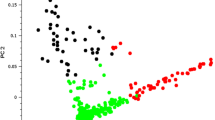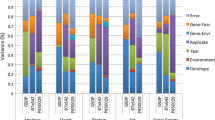Abstract
Vitamin E refers to eight distinct compounds collectively known as tocochromanols and can be further divided into two classes, tocotrienols and tocopherols. Tocochromanols are the major lipid-soluble antioxidants in maize (Zea mays L.) grain. Enhancing vitamin E content of maize through plant breeding has important implications for human and animal nutrition. Four inbred lines exhibiting unique variation for tocochromanol compounds were chosen from the Goodman maize diversity panel to construct two biparental mapping populations (N6xNC296 and E2558xCo125). The N6xNC296 population was developed to analyze segregation for α-tocopherol and α-tocotrienol content. The E2558WxCo125 population was developed to analyze segregation for the ratio of total tocotrienols to tocopherols. The tocochromanol variation in two replicates of each population was quantified using liquid chromatography-diode array detection. Using high-density linkage mapping, novel quantitative trait loci (QTL) in the N6xNC296 population were mapped using tocopherol ratio traits. These QTL contain the candidate gene homogentisate phytyltransferase (ZmVTE2) within the respective support intervals. This locus was not mapped in a previous genome-wide association study that analyzed tocochromanols in the Goodman diversity panel. Transgressive segregation was observed for γ- and α-tocochromanols in these populations, which facilitated QTL identification. These QTL and transgressive segregant families can be used in selection programs for vitamin E enhancement in maize. This work illustrates the complementary nature of biparental mapping populations and genome-wide association studies to further characterize genetic variation of tocochromanol content in maize grain.


Similar content being viewed by others
References
Andorf CM, Lawrence CJ, Harper LC, Schaeffer ML, Campbell DA, Sen TZ (2010) The locus lookup tool at MaizeGDB: identification of genomic regions in maize by integrating sequence information with physical and genetic maps. Bioinformatics 26(3):434–436. https://doi.org/10.1093/bioinformatics/btp556
Basten CJ, Weir BS, Zeng Z-B. 1994 Zmap-a QTL Cartographer. In: Smith C, Gavora JS, Benkel B, Chesnais J, Fairfull W, Gibson JP, Kennedy BW, Burnside EB (ed) Proceedings of the 5th World Congress on Genetics Applied to Livestock Production: Computing Strategies and Software. Organizing Committee, 5th World Congress on Genetics Applied to Livestock Production, p 65–66
Borek C (2004) Dietary antioxidants and human cancer. Integr Cancer Ther 3(4):333–341. https://doi.org/10.1177/1534735404270578
Bouis HE, Welch RM (2010) Biofortification—a sustainable agricultural strategy for reducing micronutrient malnutrition in the global south. Crop Sci 50(Supplement 1):S-20–S-32. https://doi.org/10.2135/cropsci2009.09.0531
Bradbury PJ, Zhiwu Zhang DE, Kroon TM, Casstevens YR, Buckler ES (2007) TASSEL: software for association mapping of complex traits in diverse samples. Bioinformatics (Oxford, England) 23(19):2633–2635. https://doi.org/10.1093/bioinformatics/btm308.
Casella G, George EI (1992) Explaining the Gibbs sampler. Am Stat 46(3):167–174. http://www.tandfonline.com/doi/abs/10.1080/00031305.1992.10475878
Chander S, Guo YQ, Yang XH, Yan JB, Zhang YR, Song TM, Li JS (2008) Genetic dissection of tocopherol content and composition in maize grain using quantitative trait loci analysis and the candidate gene approach. Mol Breed 22(3):353–365. https://doi.org/10.1007/s11032-008-9180-8
Churchill GA, Doerge RW (1994) Empirical threshold values for quantitative trait mapping. Genetics 138(3):963–971
DellaPenna D (2005) Progress in the dissection and manipulation of vitamin E synthesis. Trends Plant Sci 10(12):574–579
Eitenmiller RR (1997) Vitamin E content of fats and oils—nutritional implications. Food Technol 51(5):78–81
lshire RJ, Glaubitz JC, Sun Q, Poland JA, Kawamoto K, Buckler ES, Mitchell SE (2011) A robust, simple genotyping-by-sequencing (GBS) approach for high diversity species. PLoS One 6(5):e19379. https://doi.org/10.1371/journal.pone.0019379.
Emmert DH, Kirchner JT (1999) The role of vitamin E in the prevention of heart disease. Arch Fam Med 8(6):537–542. http://www.ncbi.nlm.nih.gov/pubmed/10575394
Falk J, Munné-Bosch S (2010) Tocochromanol functions in plants: antioxidation and beyond. J Exp Bot 61(6):1549–1566. https://doi.org/10.1093/jxb/erq030
Federer WT, Raghavarao D (1975) On augmented designs. Biometrics 31(1):29–35. https://doi.org/10.2307/2529707
Fitzpatrick TB, Basset GJC, Borel P, Carrari F, Dellapenna D, Fraser PD, Hellmann H et al (2012) Vitamin deficiencies in humans: can plant science help? Plant Cell 24:395–414. https://doi.org/10.1105/tpc.111.093120.
Flint-Garcia SA et al (2005) Maize association population: A high-resolution platform for quantitative trait locus dissection. Plant J 44(6):1054–1064
Fryer MJ (1992) The antioxidant effects of thylakoid vitamin E (alpha-tocopherol). Plant Cell Environ 15(4):381–392. https://doi.org/10.1111/j.1365-3040.1992.tb00988.x
Gibson G (2012) Rare and common variants: twenty arguments. Nat Rev Genet 13(2). Nature Publishing Group):135–145. https://doi.org/10.1038/nrg3118
Gilmour AR, Gogel BJ, Cullis BR, Thompson R (2009) ASReml User Guide Release 3.0. VSN International Ltd. http://vsni.de/downloads/asreml/release3/UserGuide.pdf%5Cnpapers3://publication/uuid/716D0761-1368-4982-AF2E-F1D8614A80DF
Havaux M, Eymery F, Porfirova S, Rey P, Dörmann P (2005) Vitamin E protects against photoinhibition and photooxidative stress in Arabidopsis thaliana. Plant Cell 17(12):3451–3469
Kamal-Eldin A, Appelqvist LA (1996) The chemistry and antioxidant properties of tocopherols and tocotrienols. Lipids 31(7):671–701 http://www.ncbi.nlm.nih.gov/pubmed/8827691
Kline K, Lawson KA, Yu W, Sanders BG (2007) Vitamin E and cancer. Vitam Horm 76:435–461
Kutner MH, Nachtsheim CJ, Neter J, Li W (1996) Applied linear statistical models. J R Stat Soc Ser A Gen. Vol. Fifth. Operations and Decision Sciences. McGraw-Hill/Irwin. doi:https://doi.org/10.2307/2984653
Lai J, Li R, Xu X, Jin W, Xu M, Zhao H, Xiang Z et al (2010) Genome-wide patterns of genetic variation among elite maize inbred lines. Nat Publ Group 42(11). Nature Publishing Group):1027–1030. https://doi.org/10.1038/ng.684
Lander E, Kruglyak L (1995) Genetic dissection of complex traits: guidelines for interpreting and reporting linkage results. Nat Genet 11(3):241–247. https://doi.org/10.1038/ng1195-241
Li Q, Yang X, Xu S, Cai Y, Zhang D, Han Y, Li L et al (2012) Genome-wide association studies identified three independent polymorphisms associated with tocopherol content in maize kernels. PLoS One 7(5):e36807
Lipka AE, Gore MA, Magallanes-Lundback M, Mesberg A, Lin H, Tiede T, Chen C et al (2013) Genome-wide association study and pathway-level analysis of tocochromanol levels in maize grain. G3 (Bethesda, Md.) 3(8):1287–1299. https://doi.org/10.1534/g3.113.006148
Lubin JH, Colt JS, Camann D, Davis S, Cerhan JR, Severson RK, Bernstein L, Hartge P (2004) Epidemiologic evaluation of measurement data in the presence of detection limits. Environ Health Perspect 112(17):1691–1696. https://doi.org/10.1289/ehp.7199
Margarido GRA, Souza AP, Garcia AAF (2007) OneMap: software for genetic mapping in outcrossing species. Hereditas 144(3):78–79. https://doi.org/10.1111/j.2007.0018-0661.02000.x
McMullen MD, Kresovich S, Villeda HS, Bradbury P, Li H, Sun Q, Flint-Garcia S et al (2009) Genetic properties of the maize nested association mapping population. Science (New York, N.Y.) 325(5941):737–740
Munné-Bosch S, Alegre L (2002) The function of tocopherols and tocotrienols in plants. Crit Rev Plant Sci 21(1):31–57. https://doi.org/10.1080/0735-260291044179
Nielsen R, Paul JS, Albrechtsen A, Song YS (2011) Genotype and SNP calling from next-generation sequencing data. Nat Rev Genet 12(6). Nature Publishing Group):443–451. https://doi.org/10.1038/nrg2986
Nielsen R, Korneliussen T, Albrechtsen A, Li Y, Wang J (2012) SNP calling, genotype calling, and sample allele frequency estimation from new-generation sequencing data. PLoS One 7(7):e37558. https://doi.org/10.1371/journal.pone.0037558
Ouahchi K, Arita M, Kayden H, Hentati F, Ben Hamida M, Sokol R, Arai H, Inoue K, Mandel JL, Koenig M (1995) Ataxia with isolated vitamin E deficiency is caused by mutations in the alpha-tocopherol transfer protein. Nat Genet 9(2):141–145. https://doi.org/10.1038/ng0295-141
R Development Core Team (2011) R: A language and environment for statistical computing. In: R Development Core Team (ed). R Foundation for Statistical Computing. R Foundation for Statistical Computing. doi:https://doi.org/10.1007/978-3-540-74686-7
SAS Institute (2012) The SAS System for Windows. Release 9.3, SAS Institute, Cary, NC
Sattler SE, Cheng Z, DellaPenna D (2004) From Arabidopsis to agriculture: engineering improved vitamin E content in soybean. Trends Plant Sci 9(8):365–367. https://doi.org/10.1016/j.tplants.2004.06.002
Shutu X, Dalong Z, Ye C, Yi Z, Shah T, Ali F, Qing L, Dalong Z, Ye C, Yi Z, Shah T, Ali F, Qing L, Zhigang L, Weidong W, Jiansheng L, Xiaohong Y, Jianbing Y (2012) Dissecting tocopherols content in maize (Zea Mays L.), using two segregating populations and high-density single nucleotide polymorphism markers. BMC Plant Biol 12:201. https://doi.org/10.1186/1471-2229-12-201.
Sorensen DA, Wang CS, Jensen J, Gianola D (1994) Bayesian analysis of genetic change due to selection using Gibbs sampling. Genet Sel Evol: GSE 26(4). BioMed Central):333–360
Stange M et al (2013) High-density linkage mapping of yield components and epistatic interactions in maize with doubled haploid lines from four crosses. Mol Breed 32(3):533–546
Swarts K, Li H, Romero AJ, An D, Romay CM, Hearne S, Acharya C (2014) Novel methods to optimize genotypic imputation for low-coverage, next-generation sequence data in crop plants. Plant Genome 7(3):12
Vinod KK (2011) Kosambi and the genetic mapping function. Resonance 16(6):540–550. https://doi.org/10.1007/s12045-011-0060-x
Wong JC, Lambert RJ, Tadmor Y, Rocheford TR (2003) QTL associated with accumulation of tocopherols in maize. Crop Sci. https://doi.org/10.2135/cropsci2003.2257
Wright M, Lawson K, Weinstein S, Pietinen P (2006) Higher baseline serum concentrations of vitamin E are associated with lower total and cause-specific mortality in the alpha-tocopherol, beta-carotene cancer prevention study. Am J Clin Nutr 84(5):1200–1207
Yang J, Zhu J, Williams RW (2007) Mapping the genetic architecture of complex traits in experimental populations. Bioinformatics (Oxford, England) 23(12):1527–1536. https://doi.org/10.1093/bioinformatics/btm143.
Yang J, Benyamin B, McEvoy BP, Gordon S, Henders AK, Nyholt DR, Madden PA, Heath AC, Martin NG, Montgomery GW, Goddard ME, Visscher PM (2010) Common SNPs explain a large proportion of the heritability for human height. Nat Gen 42(7):565–569
Zeng ZB (1993) Theoretical basis for separation of multiple linked gene effects in mapping quantitative trait loci. Proc Natl Acad Sci U S A 90(23):10972–10976. https://doi.org/10.1073/pnas.90.23.10972
Zeng ZB (1994) Precision mapping of quantitative trait loci. Genetics 136(4):1457–1468
Acknowledgments
The authors thank Dean DellaPenna at Michigan State University for providing training and guidance on how to perform the tocochromanol phenotyping.
Funding
This research was supported by the National Science Foundation (NSF) DBI-0922493 (D.D.P., C.R.B, E.S.B., and T.R.R.).
Author information
Authors and Affiliations
Corresponding author
Ethics declarations
Conflict of interest
The authors declare that they have no conflict of interest.
Rights and permissions
About this article
Cite this article
Fenton, M.E., Owens, B.F., Lipka, A.E. et al. High-density linkage mapping of vitamin E content in maize grain. Mol Breeding 38, 31 (2018). https://doi.org/10.1007/s11032-018-0780-7
Received:
Accepted:
Published:
DOI: https://doi.org/10.1007/s11032-018-0780-7




